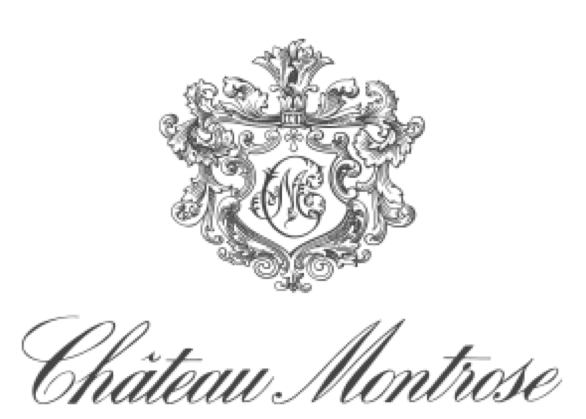Château Mauvesin Barton
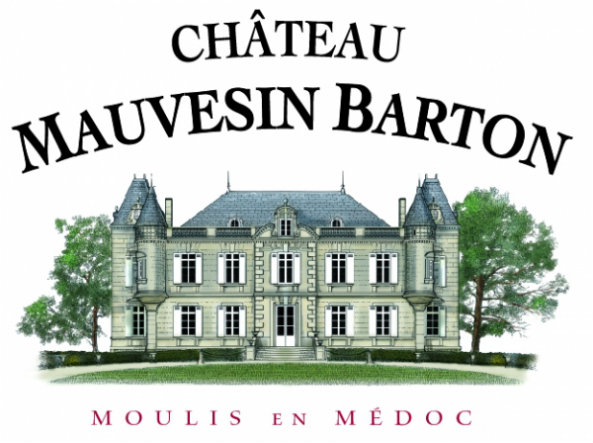
The Estate
The history of Chateau Mauvesin dates back to the 15th century. It was in 1457 that Jean de Foix Grailly became proprietor of the first Chateau de Mauvesin in the district of Moulis en Médoc. At this time, it was a true fortified castle with towers and battlements. 50 years later, it was acquired by the La Rivière family through the marriage in 1582 of Marguerite de La Rivière with Jacques Le Blanc, who became lord of Mauvesin. Soon after the Revolution in 1792, the old chateau was seized by the state and put up for sale in Lesparre, where it was attributed to “citizen” Clarcke acting for the account of Pauline Le Blanc. The old chateau remained the property of the family but due to its state of ruin, it was demolished in 1852.
The construction of the present chateau in 1853 on the site of the original chateau is thanks to Marquis Lodoïs Le Blanc de Mauvesin and his wife. On the advice of architect Perrier and inspired by the style of Louis XIII, the chateau consists of “two pavilions and two turrets, combining elegance and solidity. The façade is upon a magnificent garden with a pond and a beautiful collection of conifers.” After 2 years labor, the chateau remains as it was when constructed in 1853 and the trees planted at the creation of the park constitute this timeless home.
Having built the chateau in 1853, the Marquis Lodoïs Le Blanc de Mauvesin died in 1884 leaving no direct heirs. He decided to leave his patrimony to his first cousin, Hyppolite de Baritault du Carpia, his closest relative. The Baritaults, an eminent family originally from the Vendée area, kept Chateau Mauvesin for 4 generations up to its sale in 2011.
The Viscount and Viscountess Alain de Baritault du Carpia, heirs of the family Le Blanc de Mauvesin, sold the property on the 4th August 2011 to Lilian and Michel Barton Sartorius. The Barton family has for eight generations been owners of the Crus Classés Langoa and Leoville Barton, situated in the Saint Julien appellation.

Château Mauvesin Barton Moulis-en-Médoc
Overview: In August 2011, The Barton Sartorius family acquired this historical wine producing estate and its Château that was re-baptized Château Mauvesin Barton. With the Barton family’s centuries of experience and unique expertise behind them, each of the four family members plays a specific role, perpetuating tradition and sharing their passion : Lilian Barton Sartorius takes on the management of the Château, Michel Sartorius takes care of the wine distribution, Mélanie Barton Sartorius becomes technical manager and Damien Barton Sartorius brings his expertise to the commercialisation of the wine.
Terroir: The vineyard is situated in the “Moulis-en-Médoc” appellation, to the north of Bordeaux, on the left bank of the Gironde estuary. Part of the soil is clay-gravel, perfectly adapted for the development of Cabernet-Franc and Merlot. Another part is made up of fine gravel and gritty sand, allowing the Cabernet Sauvignon to reach full ripeness. As for all the Barton family activities, great importance is attached to environmental protection and the quality of the wines produced. The 55 hectares of vines comprise 54% Merlot, 35% Cabernet Sauvignon and 11% Cabernet Franc.
Alcohol Content: 13.5%
Vinification: The younger vines are picked by hand. After careful selection, the grapes are placed in temperature-controlled stainless steel vats for the fermentation and maceration phase. The ageing process lasts 12 to 15 months, in French oak barrels of which one third are new. The casks rest on a gravel bed to regulate humidity.
Aging: 1/3 new wood barrels
Tasting Notes: Ruby color, nose of toasted hazelnut and red fruits (cherry, blueberry). Delicate tannins. Wine with balance and finesse. Fresh, almost minty finish. Nice length and drinkability.

L’Impression de Mauvesin Barton
Overview: L’Impression de Mauvesin Barton is the second wine of Château Mauvesin Barton. The second wine is the result of the selection of the Grand Vin.
Owner: Barton-Sartorius family
Vineyard Manager: Laurent Crouzet
Cellar Master: Bruno Petit
Production Area: 42 hectares
Location: Located in Moulis-en-Médoc, Castelnau and Avensan towns, 30 km North of Bordeaux
Soil: Calcareous clay conducive to the development of Cabernet Franc and Merlot, with some gravel and sand to achieve an exceptional Cabernet Sauvignon
Average Age of the Vines: 35 years old
Pruning: Double cane pruning, weed on the rows, reasoned additives
Grape Varieties: Merlot 50%, Cabernet Sauvignon 35%, Cabernet Franc 15%
Harvest: Optical sorting at the reception of the harvest, vibrating dump
Vinification: Plot by plot vinification, thermo-regulated, stainless-steel vats of small volume, maceration and fermentation in tank
Aging: In barrels
Average Yield: 45 hl/ha
Alcohol: 13%
Production: Approx. 75,000 bottles
Tasting Notes: Ruby color with toasted notes and a ripe nose. On the palate, silky tannins and a good aromatic persistence.
Château Mazeyres (Biodynamic)

The Estate
Château Mazeyres, situated at the heart of Libourne, is intimately linked to the history of Pomerol. Its location was active and bustling during the Roman period. Anecdotally, Its plateau (then served by 2 main roads) was borrowed by the poet Ausone to go to the villa Lucaniac. Remarkable fragments of pottery dating back to the 3rd Century have been discovered on the site of the Chateau. These artifacts attest to the existence of a Gallo-Romaine villa here in the past. The town archives show that viticulture was first introduced to this area in the 14th Century.
At the beginning of the 20th Century, Chateau Mazeyres was acquired by the Querre family who were dedicated to producing fine, fruity wines that would be destined for the clientele of top class French restaurants. It was in 1998 that the family decided to sell the entire property to Société Générale’s Pension Fund, which in 2010 would be sold to Sogecap, the Life Insurance branch of the same company.
In 1992, Alain Moueix, wine engineer and œnologue, was entrusted with the management of Château Mazeyres. Representing the 4th generation of a noted family of winemakers and négociants from Libourne, he brought his commitment, expertise, and know-how to the job.
Since 2012, the estate has been certified biodynamic, and the recent acquisition of 4 supplemental hectares at the heart of the Pomerol appellation brings the total surface area that is certified to 25.5 hectares.
Director: Alain Moueix
Vineyard Manager: Jean-Michel Bernard
Winemaker: Ludovic Guibert

Château Mazeyres Pomerol
Production Area: 25.57 hectares / 62 acres
Terroir: Gravel and clay with iron in the subsoil, and also sandy, gravelly soils
Grape Varieties: 73.1% Merlot, 24.3% Cabernet Franc, 2.6% Petit Verdot
Average Age of the Vines: 30 years old
Harvest: By hand with double sorting
Vinification: Gentle extraction by both pumping over and plunging in temperature controlled vats (Concrete and Stainless steel)
Aging: 14 months in oak barrels (30% new)
Average Yield: 40 hectoliters/ha
Tasting Notes: Violet color with purple glints. The nose is very intense and refreshing. Bouquet with fresh fruits (blackberry, blueberry) and a delicate spicy hint. The first touch in the mouth is elegant. The tannins give a general sensation of freshness, offering a very nice balance and bright fruit on the finish. The tannins are velvety and elegant in the meantime. The wine is juicy and has a minerally aftertaste.
Cellaring Potential: 10 to 15 years
2015 Reviews: “The 2015 Mazeyeres is creamy, suave and expressive. Sweet tobacco, herbs, cedar, red plum, and licorice add attractive complexity in this mid-weight, nuanced Pomerol, an impression that is reinforced by the silky tannins. This is very nicely done.”-92pts, Vinous

Le Seuil de Mazeyres
Overview: Le Seuil de Mazeyres is the Second Wine of Chateau Mazeyres
Production Area: 25.57 hectares / 62 acres
Terroir: Gravel and clay with iron in the subsoil, and also sandy, gravelly soils
Grape Varieties: 73.1% Merlot, 24.3% Cabernet Franc, 2.6% Petit Verdot
Average Age of the Vines: 30 years old
Harvest: By hand with double sorting
Vinification: Gentle extraction by both pumping over and plunging in temperature controlled vats (Concrete and Stainless steel)
Aging: 50-50 in oak barrels of one year old and tanks
Average Yield: 38 hectoliters/ha
Annual Production: 30,000-60,000 bottles
Tasting Notes: Pretty garnet color. The nose is elegant with a certain complexity of sour cherries and sweet spices. The attack is supple, unctuous and fruity. The wine develops with melted tannins, a touch of velvet and a beautiful freshness. The finish offers a nice return of black fruits and a touch of light toasted oak. This harmonious wine presents a beautiful balance.
Château Meyney (Sustainable)
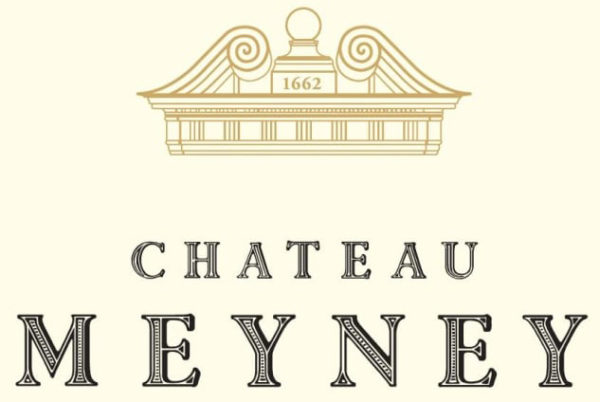
The Estate
Château Meyney is one of the oldest estates in the Médoc. In 1662, it was a convent mentioned in records under the names “Couvent des Feuillants” or “Prieuré des Couleys”. Today, the estate stretches over some of the best hilltops above the Gironde Estuary. The river lying alongside the first rows of vines makes for a majestic, serene landscape.
The estate belonged to the Luetkens family for several generations, and was then acquired by Mr. Désiré Cordier in 1919. In 2004, CA Grands Crus, a subsidiary of the Groupe Crédit Agricole, acquired Château Meyney, with a determination to strengthen the potential of this outstanding cru. An improvement plan was put together for the entire estate. It is supervised today by Anne Le Naour, the Technical Director, and the consultant oenologist, Hubert de Bouärd.
The company CA Grands Crus, a fully-owned subsidiary of the Groupe Crédit Agricole, became, in 2004, the owner of prestigious Bordeaux estates: Château de Rayne Vigneau, 1er Grand Cru Classé Sauternes, Château Grand-Puy Ducasse, 5ème Grand Cru Classé Pauillac, Château Meyney, Saint-Estèphe, Château Blaignan, Cru Bourgeois Médoc.
Terroir
The château lies at the center of a single block vineyard of 51 hectares (126 acres), overlooking the Gironde. The presence of the estuary protects the estate from frosts. The vineyard is planted on Garonne gravels. The vines are an average age of 35-40 years old, divided between 60% Cabernet Sauvignon, 30% Merlot, and 10% Petit Verdot. The vines climb to an altitude of 20 meters up, quite a steep slope, ensuring good natural drainage of the soil. Similar to “Pétrus”, a layer of blue clay about 3-meters thick lies at a depth of 2.6 meters below the surface. These remarkable natural factors give the wine an exceptional richness.

Château Meyney Saint-Estèphe
Soil: Garonne Gravels, clay-limestone
Average Age of the Vines: 35-40 years
Grape Varieties: 60% Cabernet Sauvignon, 25% Merlot, 15% Petit Verdot
Viticulture: Parcel management of soil and vineyard. Certified sustainable farming.
Vinification: Following hand-picking and selection of the grapes on the vine, the grapes are carefully selected in the winery, passing through a brand-new optical sorting machine. The grapes are then fermented in vats of varying capacities, which allow us to adapt to the size of each batch. The fermentation starts after a few days of cool soaking. After fermentation, maceration continues for an average of 30 days before the wine is run off. Part of the wine goes through malolactic fermentation in new barrels.
Aging: The wine is aged in French oak barrels from 18-24 months depending on the vintage. 40% of the barrels are renewed each year.
Average Yield: 50 hl/ha
Production: Around 160,000 bottles
Tasting Notes: The unusually high share of Petit Verdot explains a particular trait of the wines, which regularly show notes of leather and musk after a period of time. The wine is full-bodied, well-rounded and structured. After aging, the wine displays the remarkable charm of the best Saint-Estèphe: complexity, balance, and harmony.
Château Monbrison
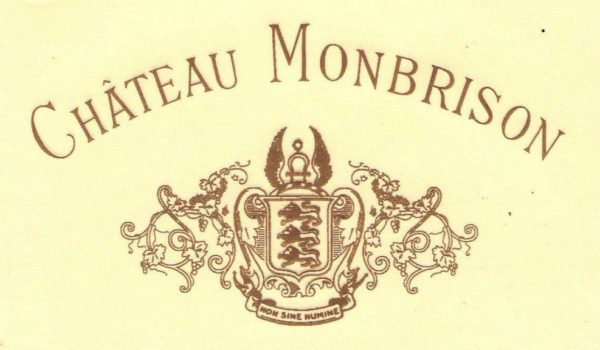
The Estate
In 1768, the widow of the Marquis de Montalambert divided the Durfort-Lascombes estate between her nephews, the Viscomte de Vivens and M. Montbrizon. In fact, what is now Château Monbrison was a métairie of the neighboring Château d’Arsac, which belonged to the powerful Ségur family. In 1749, it was ceded as an independent estate to M. De Copmartin, an advisor to the king in Bordeaux, and it remained in the hands of the Copmartin family until 1818. In February 1818, Madame François-Pierre Copmartin, née Anne Faure, sold her Arsac Domaine, at this time relatively small for a vineyard, to Paul George Conquère de Monbrison for 75,000 francs.
Originally of German origin, it was Elizabeth Davis who bought out her sisters, rented back some of the land her mother had sold off after the war, and supervised the replanting of the derelict vineyard. Once, causing much aeronautical confusion, she released an anti-hail rocket into a threatening cloud. It hit an aircraft which had just taken off from Bordeaux’s Mérignac airport! Elizabeth Davis is still the dominant figure at Monbrison. Her second son, Jean-Luc, was responsible for the wine from 1976 until his tragic early death from leukemia in 1992. Today it is the third son, Laurent, who had lived and operated his own wine business in the U.S. for a dozen years or so, who returned to take over. From 1974 to 1983, 6 of the 10 hectares of Monbrison were leased to Alexis Lichine of the Prieuré and went into Prieuré-Lichine. Now re-instated, the Domaine has been further increased by Elizabeth Davis’ own farming arrangements nearby to a total of 13.2 ha, plus a further 7.4 ha at Cordet.
The vines are planted in a ratio of 50% Cabernet Sauvignon, 15% Cabernet Franc, 30% Merlot, and 5% Petit Verdot, and lie more or less in one piece, on the edge of the plateau known as the Poujeaux, adjoining du Tertre and Angludet on one side, and Giscours on another, alongside the road which runs from Arsac to Macau. The wine is vinified in enameled steel vats at a maximum temperature of 32-33°, given a long cuvaison, and aged, in the best years, in as much as 50% new wood. There is of course a green harvest – Jean-Luc Vonderheyden was one of the first to adopt this crop-thinning technique – though not in 1988 or again in 1992 when hail reduced the harvest naturally. A new barrel cellar was constructed in 1978, and a new storage cellar and reception area in 1987.
The wine of Monbrison has, since 1982 at least, not put a foot wrong. Partly this is as a result of what is now a respectable age of the vineyard. Principally though, it was the application of the considerable talents of Jean-Luc, now continued by the equally able Laurent Vonderheyden. The vineyards have undergone a parallel process of refinement, becoming richer and more concentrated over the years, remaining sturdy for a Margaux, yet nevertheless showing an inherent plummy velvetiness, or at least promising it for maturity, which is characteristic of the Margaux commune.

Château Monbrison Margaux
Production Area: 13.2 hectares
Average Age of the Vines: 40 years old
Soil: Deep gravel
Grape Varieties: Cabernet Sauvignon, Merlot, Cabernet Franc, Petit Verdot (percentages vary depending on the vintage)
Vineyard: Mechanical working of the soil, reasoned use of herbicides. Premature thinning out of leaves.
Harvest: Hand harvested into 30 kg picking boxes. Double sorting of the grape harvest.
Aging: 18 months in French oak barrels (40% new wood). No filtration.
Tasting Notes: Château Monbrison is a robust and dense wine, with a touch of tenderness and generosity. It is tannic and powerful when young, but after aging it bursts with flavor and smooth tannins.

Haut-Médoc de Monbrison
Location: Shared between 2 appellations: Moulis and Listrac
Production Area: 3 hectares
Average Age of the Vines: 25 years old
Soil: Sandy gravel and clay for the Moulis terroir and sandy gravel for Listrac
Vineyard: Mechanical working of the soil, reasoned use of herbicides. Premature thinning out of leaves.
Grape Varieties: Cabernet Sauvignon and Merlot (percentages vary depending on the vintage)
Average Yield: 52 hl/ha
Harvest: Hand harvested into 30 kg picking boxes. Double sorting of the grape harvest.
Aging: 12 months in French oak barrels (25% new wood).
Château Montrose
History
The story of Montrose, written by three families of owners over twocenturies. As pioneers in the Médoc, visionary builders and astute managers, they tended and got the best out of its unique terroir.
Théodore Dumoulin
He discovered the patch of heathland that everyone had forgotten about. In 1815, he planted the vineyard and built the necessary facilities to operate the estate and make the wine. 1855 marked the birth of a Grand Cru with the inclusion of Château Montrose in the official classification, a spectacular achievement for a vineyard barely 40 years old.
Encouraged by this success, Etienne Théodore Dumoulin continued to expand his vineyard. On his death in 1861 he left his heirs an estate spanning 95 hectares (234 acres), its current size.
Mathieu Dolfus
He acquired Montrose in 1866 and began to reorganise the estate. Designer of the “Montrose village” with its squares and streets, he had a huge influence on the life of the estate. A visionary entrepreneur, he managed to halt the scourge of phylloxera by installing a windmill which pumped water from an underground well and flooded the land, saving the vineyard. The windmill, preserved by successive generations of owners, is now one of the symbols of Montrose.
Jean-Louis Charmolue
From 1896 to 2006, following in the footsteps of Mathieu Dollfus the builder after his death in 1886, the Charmolüe family guided the estate along the path of stability and excellence.
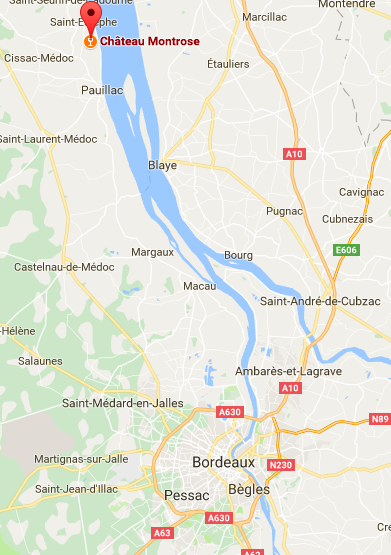
The Terroir
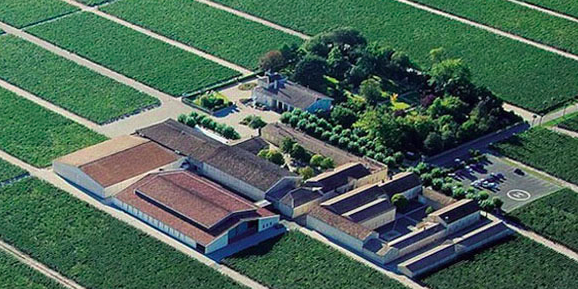 Blessed with undisputed natural assets combined with advantages nurtured over the centuries, Château Montrose has one of the region’s most privileged winegrowing terroirs. The Montrose terroir corresponds to what geologists call “elite cores”. Over millions of years, a complex process of geological layering resulted in the creation of outcrops, ideal for making fine wines and ensuring natural drainage towards the estuary.
Blessed with undisputed natural assets combined with advantages nurtured over the centuries, Château Montrose has one of the region’s most privileged winegrowing terroirs. The Montrose terroir corresponds to what geologists call “elite cores”. Over millions of years, a complex process of geological layering resulted in the creation of outcrops, ideal for making fine wines and ensuring natural drainage towards the estuary.
The soil on these terraces consists of gravel mixed with sand on the surface over a clay-rich subsoil in which natural reserves form at depth, providing the vines with the water they need.
At Château Montrose, the largest parcel is two hectares (five acres), the smallest only a few hundred square metres, but each has its own personality, its own particular soil or subsoil, and vines whose age, yield, variety or rootstock are different from those of its neighbour. In the end it is the wine itself which, in its own way, brings this amazing patchwork together, since it is both the result and the synthesis of each micro-terroir.
Five kilometres north of Pauillac in Saint-Estèphe, the northernmost appellation in the Médoc, Château Montrose is situated on a very well-drained and ideally exposed gravelly outcrop which runs for over a kilometre along the Gironde estuary.
The presence of a broad estuary, the largest in Europe, has a decisive effect on the local microclimate. Montrose is one of the few estates to enjoy such a highly privileged situation.
The proximity of this vast water mass acts as a natural regulator. It attenuates the excessive cold which can be so devastating in the form of spring frosts,
and it tempers the destructive effect of heatwaves which starve the vines and grapes of water in the height of summer. That is why the Montrose vineyard escaped the frost in 1991 and the development of botrytis during the 2013 harvest.
Montrose’s situation, on an outcrop overlooking the estuary, is precious to the vineyard because of its exposure to wind and sun. The rows of vines are planted north-south, enabling the grapes to take full advantage of the sun throughout the day. The dominant north-west winds dispel excessive humidity when it rains.
The mix of grape varieties at Montrose, with Cabernet Sauvignon predominant (60% of the vines), is typical of the finest Médoc estates. Cabernet Sauvignon gives its best on warm, gravelly and permeable soil with clay subsoil which helps to store the water the vines need in drought conditions. The Garonne gravel terroirs found at Montrose are its preferred home.
Parcels of Merlot (32%), Cabernet Franc (6%) and Petit Verdot (2%) are also planted where the soil suits them best, enabling the grapes to reach full maturity and express the complexity typical of the terroir.
Each variety is planted on the terroir, in the parcel and with the density that will optimise its qualities.
At Montrose, Merlot brings a gentle, feminine touch along with silky tannins and aromatic flavours. Cabernet Franc is a very high-quality variety, known for its elegant aromas, which gives fresh and complex wines, while Petit Verdot brings colour, along with pleasant spice and pepper flavours.
Vinification
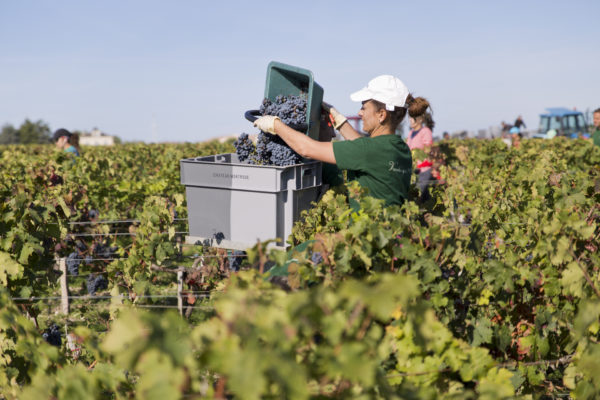 After an initial selection in the vineyard during picking, the grapes are brought to the vat-house. The individual grapes are then sorted optically and again by hand before being finally transferred to the vats. The wines are vatted for 25 days at most, respecting the fruit and the substance. All the lots are kept separate after running-off so that all the different profiles of the vat wines are available for blending. Blending tastings start in December. All the samples – nearly 60 different lots – are tasted and classified according to their style and profile. They are then selected and blended according to the personality sought for each wine.
After an initial selection in the vineyard during picking, the grapes are brought to the vat-house. The individual grapes are then sorted optically and again by hand before being finally transferred to the vats. The wines are vatted for 25 days at most, respecting the fruit and the substance. All the lots are kept separate after running-off so that all the different profiles of the vat wines are available for blending. Blending tastings start in December. All the samples – nearly 60 different lots – are tasted and classified according to their style and profile. They are then selected and blended according to the personality sought for each wine.
From January, each vintage is barrel-matured in a specific barrel hall.
The Premium Wine, Château Montrose, is matured for 18 months in 60% new French oak barrels from eight different coopers.
For the second wine, La Dame de Montrose, the proportion of new barrels is 30% and the wine is matured on average for 12 months.
The Saint-Estèphe de Montrose is matured for 12 months in 20% new barrels.
During the maturing process the wines are racked every three months or so. The traditional method used at Montrose involves transferring the wine from one barrel to another by gravity so that the clear wine can be perfectly separated from the lees which settle naturally at the bottom of the barrel.
Fining is carried out in barrels in the traditional way, with fresh egg whites, in order to refine the wine and soften the tannins.

Chateau Montrose Saint-Estèphe 2ème Cru Classé
Overview: The result of rigorous selection at each stage of production, in both the vineyard and the winery, this great, predominantly Cabernet Sauvignon wine is typical of the Saint-Estèphe appellation. Structured and tannic but with all the elegance and refinement of a Grand Cru Classé, with time it develops a delicate and complex bouquet. This wine has considerable aging potential and is exceptionally long-lived. Certain vintages (1921, 1929, 1982, 1990, 2009) are considered legendary.
Grape Varieties: Cabernet Sauvignon, Merlot, Cabernet Franc, Petit Verdot
Aging: Matured for 18 months in 60% new oak barrels, the premium wine accounts on average for 55% of the estate’s total production.
Tasting Notes: Dense and profound color. Complex nose delivering aromas of morello, blond tobacco and chocolate. Slightly wooded. Long and full on the palate with aromas of morello, raspberry, mocha. Supple and long finish on neat and coated tannins. Balanced and harmonious. The tasting was very homogeneous, soft and silky.

La Dame de Montrose
Overview: Made to the same rigorous standards as the first wine, from grapes grown in the same vineyard, La Dame de Montrose is the estate’s second label. Consistently reliable and reaching maturity sooner, the wine was created in 1986 in tribute to Yvonne Charmolue, who ran Château Montrose single-handedly from 1944 to 1960.
Annual Production: Production varies from year to year but accounts on average for 30% of the total production of the Montrose vineyard.
Aging: It is matured for 12 months in 30% new oak barrels.
Tasting Notes: Supple and silky Merlot generally predominates in the varietal mix. Its very pronounced red fruit aromas and flavors reflect another expression of the terroir in a distinctive style which is less elaborately complex than that of the first wine.

Tertio De Montrose
Overview: Third blend made from batches of the younger vines and the lees wines, the Tertio de Montrose is produced on the exceptional terroir of Château Montrose and vinified by its teams. Named Saint-Estèphe de Montrose when created in 2008, it was renamed Tertio de Montrose in 2016. This wine is made with the same quality requirements as the Grand Vin and La Dame de Montrose selections. Typical of the Bordeaux blends, it can be enjoyed in its early years.
Grape Varieties: Cabernet Sauvignon, Merlot, Cabernet Franc, Petit Verdot
Harvest: Mid-September
Aging: 12 months in barrels (of which 15% are new)
Winemaker Tasting Notes: “The color is a beautiful cherry red. The nose reveals aromas of red fruit accompanied by some spicy and lightly smoky notes. The attack, full and round, reveals beautiful freshness on the palate.”
Château Mouton Rothschild
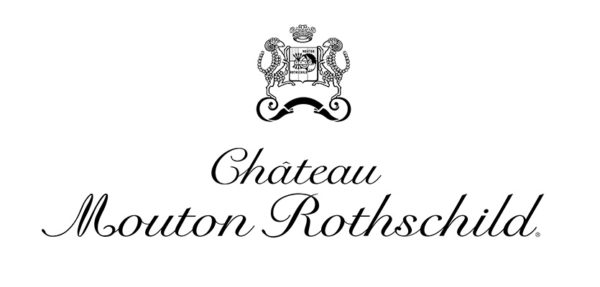
The Estate
The name “Mouton Rothschild” has 2 origins. “Mouton” is translated to “small hill,” which is a reference to the terroir on which the estate is planted. “Rothschild” or “Red Shield” was derived from the house where a Rothschild ancestor lived in Frankfurt. The Rothschild family were merchants in the mid-18th century, and having made a fortune in their family business, in 1853 they purchased the Brane Mouton chateau in Bordeaux. Brane Mouton was renamed Mouton Rothschild, and extensive replanting was commenced as the vines were in a poor state.
In the early 1920s, the very young Baron Philippe Rothschild assumed control of the estate and proceeded to influence how Bordeaux wine would be made and sold for years to come. In the original 1855 Classification, Mouton Rothschild was awarded Second Growth status. Spurred by his great desire to earn First Growth status for Mouton Rothschild, in the astonishingly short period of 2 years the Baron made several innovations. First, he introduced the practice of estate bottling which was highly unusual at the time. This gave him total control over his product, at a time when wine was typically sold in barrels to négociants who would handle the bottling. Second, he also began the tradition of hiring an artist to design the wine labels, beginning in 1924 with Cubist artist Jean Carlu. Carlu was succeeded by many famous artists over the years, such as Dali, Miro, Chagall, Braque, Picasso, and Warhol. Third, Baron Philippe was also the first to create a branded wine that was world renowned and sold at a reasonable price for consumers.
Since the estate was now bottling their wine on premise, this created a need for more storage space, and so in 1926 the young Baron began construction of the famous “Grand Chai” of Mouton Rothschild.
He also added to the estate holdings in 1933, with the purchase of Château Mouton d’Armailhacq (later Chateau d’Armailhac), and in 1970 with the purchase of Chateau Clerc Milon.
Eventually, after many years of hard work and dedication, Baron Rothschild finally succeeded in changing the 1855 classification of Mouton Rothschild to First Classified Growth, the first person to ever do so.
Baroness Philippine de Rothschild, daughter of Baron Philippe, succeeded her father in 1988 who passed away that year.
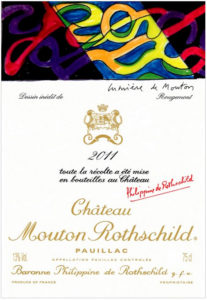
Château Mouton Rothschild Pauillac 1er Grand Cru Classé
Production Area: 75 hectares
Grape Varieties Planted: 80% Cabernet Sauvignon, 16% Merlot, 3% Cabernet Franc, and 1% Petit Verdot (percentages vary depending on the vintage)
Terroir: Gravel, rocks, sand, clay, and limestone. The gravel goes as far as 5 meters below ground.
Average Age of the Vines: 50-100 years old, with the oldest vines being planted in 1890
Plant Density: 10,000 vines per hectare
Location: The vines are situated on the “Mouton plateau,” or the “Grand Plateau,” a small hill that rises about 29 meters above sea level, one of the highest elevations in Pauillac. They are planted mostly in one large block. Lafite Rothschild lies just to the north, and Pontet-Canet is their immediate neighbor next door.
Vineyard: The same people work the same vineyard plots every year to ensure special care of the vines. The vines are tied after they are pruned. The young plants are trained in the spring to allow the tractors to pass through and work the soil. Green harvesting and crop thinning are sometimes practiced.
Harvest: Manually picked into 12 kilo open baskets. The young vines are harvested first and are fermented separately. The grapes are sorted by hand before destemming.
Vinification: In temperature-controlled, 225-hectoliter wooden vats. Malolactic fermentation takes place in tank.
Aging: 100% new, French oak barrels for 19-22 months.
2003 Reviews: “…the nose offers up notes of cedarwood, roasted coffee, tobacco leaf and red and blackcurrants…spicy, earthy, fleshy, medium to full-bodied…” – 91pts, Robert Parker
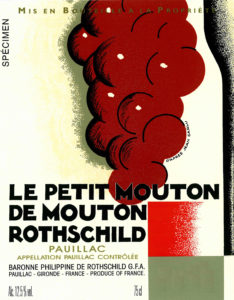
Le Petit Mouton de Mouton Rothschild
Overview: Produced from an exceptional terroir, Le Petit Mouton de Mouton Rothschild is the second wine of Château Mouton Rothschild. Made with grapes from selected younger vines in the illustrious First Growth vineyard, it is harvested, vinified and bottled with the same scrupulous attention to detail. Harvested in small, open baskets, fermented in the Mouton oak vats, matured in oak barrels in the traditional way, all the conditions are met for the wine to express the elegance and richness of a great Pauillac. In order to link the second wine more closely with its famous elder, illustrated by great artists since 1945, Baroness Philippine de Rothschild has chosen a label for Le Petit Mouton inspired by a drawing by the famous poster artist Jean Carlu. The first vintage, 1993, was called Le Second Vin de Mouton Rothschild, but it has borne its definitive name (which has a family connotation, Petit Mouton being the name of Baroness Philippine’s residence in the heart of the estate) since the following year, 1994.
Grape Varieties Planted: 80% Cabernet Sauvignon, 16% Merlot, 3% Cabernet Franc, and 1% Petit Verdot (percentages vary depending on the vintage)
Terroir: Gravel, rocks, sand, clay, and limestone. The gravel goes as far as 5 meters below ground.
Average Age of the Vines: 50-100 years old, with the oldest vines being planted in 1890
Plant Density: 10,000 vines per hectare
Location: The vines are situated on the “Mouton plateau,” or the “Grand Plateau,” a small hill that rises about 29 meters above sea level, one of the highest elevations in Pauillac. They are planted mostly in one large block. Lafite Rothschild lies just to the north, and Pontet-Canet is their immediate neighbor next door.
Vineyard: The same people work the same vineyard plots every year to ensure special care of the vines. The vines are tied after they are pruned. The young plants are trained in the spring to allow the tractors to pass through and work the soil. Green harvesting and crop thinning are sometimes practiced.
Harvest: Manually picked into 12 kilo open baskets. The young vines are harvested first and are fermented separately. The grapes are sorted by hand before destemming.
Vinification: In temperature-controlled, 225-hectoliter wooden vats. Malolactic fermentation takes place in tank.
Aging: 100% new, French oak barrels for 19-22 months.
Château Nenin
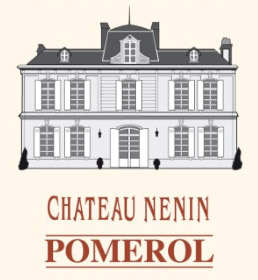
History
On the eve of the 1997 harvest, Jean-Hubert Delon purchased Château Nénin, which had belonged to his cousins, the Despujol family, since 1847. A major restructuring was immediately undertaken.
The pruning and trellising methods were reviewed, the land was drained, the vines were replanted or uprooted, and the equipment modernized. The aging and storage cellars were extended and completely re-fitted, and air conditioning was added. A new vat room, furnished with state-of-the-art equipment, was built thereby completing the total transformation of the property.
Terroir
Château Nénin’s vineyards grow on a single block of land with the exception of one plot. In Pomerol, where it is rare for an estate to exceed 10 hectares, Château Nénin’s vineyard is considered very large, with 32 hectares of vines in production. As a consequence, its terroir includes the many, diverse soils that characterize Pomerol. It is mainly made up of Oligocene deposits covered by Dordogne alluvial gravelly formations; siliceous clay and gravel, quartz, granite, iron-deposits and basalt pebbles. Château Nénin’s vineyards grow on the great clay-gravel terroirs of the Pomerol Plateau. The grape varieties planted are Merlot 76%, Cabernet Franc 23%, and Cabernet Sauvignon 1%.

Château Nenin
Overview: According to the Delon family, Château Nénin is the epitome of a great Pomerol “vin de garde” (wine for laying down). It combines power and elegance, complexity and balance, purity and refi nement. The gradual increase of Cabernet Franc within the vineyards gives the wine tautness, distinction and freshness. To really appreciate the Grand Vin’s ageing ability, you may need to be patient. Like all great Pomerol vins de garde, Château Nénin blossoms over time.
AOC: Pomerol
Production Area: 32 ha
Grape Varieties: Merlot, Cabernet Franc (percentages vary depending on the vintage)
Average Age of Vines: 28 years
Density of Plantation: 6,300 to 7,100 plants/ha
Aging: Château Nenin is aged in 30% new oak (or less) for an average of 18 months
Alcohol: 14.5%
Acidity: 3.44 gH2SO4/l
1998 Reviews: “Crushed blackberries, with coffee and smoked meat on the nose. Full-bodied, with very velvety tannins and a long finish, with a beautiful mouthfeel. Why wait on this beauty?” – 92pts, Wine Spectator

Fugue de Nénin
Overview: Fugue de Nénin was created and first sold in 1997. Fugue comes from sandy-clay soils found in the eastern part of the Château’s vineyards, as well as from the young vines planted on the great plateau terroirs. This second wine is a typical example of the charm of Pomerol. Fugue is a reference to music; it means a repetition of the main theme. This name makes sense when you taste the wine – Fugue complements the tonalities of its older sibling extremely well, while providing its own attractive and entertaining rendition. The wines are smooth and silky and can be enjoyed earlier than those of the Grand Vin.
Grape Varieties: Merlot, Cabernet Franc (percentages vary depending on the vintage)
Alcohol: 13%
Acidity: 2.91 gH2SO4/l
Tasting Notes: Intense garnet color. The nose is fine, elegant, with notes of red fruit and citrus. On the palate, the tannins are supple with fruity hints.
2015 Reviews: “There is a very fine purity on the nose here, especially considering that this is a deuxième vin, a mixture of red and black fruit, a touch of cedar from the Cabernet Franc emerging with time. The palate is medium-bodied with light and crisp tannin, tensile in the mouth with charcoal-tinged black fruit that tapers slightly towards the finish.” – 90pts, Wine Advocate
Château Olivier
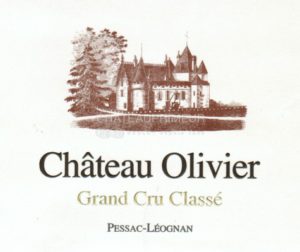 Overview
Overview
At the heart of a vast estate containing forests, prairies and vines, Château Olivier sit like a clearing emerging from its woods. Its beautiful architecture, its bodies of water and the quality of its annex buildings all add up to make an exceptional site in natural surroundings, situated only eleven kilometres from Bordeaux.
History
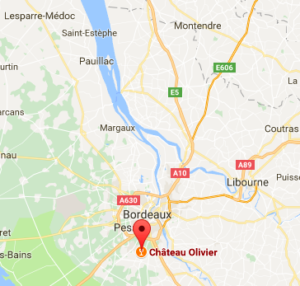
Olivier is a very old seigniory, dating back to the Middle Ages. It is said that the Black Prince enjoyed coming here to hunt, as the surrounding forests were so well-stocked in game. Since the 19th century, the estate has belonged to an old Bordeaux family in the shape of the Bethmanns. Château Olivier wines received official classification in 1953, for both red and white varieties. In 1867, Alexandre de Bethmann was elected mayor of Bordeaux, then his family acquired Château Olivier, which is still managed today by one of his descendants. Nowadays the Bethmann family is continuing their work at Olivier. Over the last few years, the vineyards of Château Olivier have seen considerable work and investment. It has entrusted the estate’s general management to Laurent Lebrun, an agronomist and winemaker. Together with Philippe Stoeckle,technical director, Marie France Hairon, administrative and financial manager, and Estelle Mirieu de Labarre in charge of sales and marketing, this forms a competent and passionate team.
Grapes varieties for red: 60% Merlot, 37% Cabernet Sauvignon, 3% Petit Verdot
Grapes varieties for white: 78% Sauvignon Blanc, 20% Sémillon, 2% Muscadelle

Château Olivier Pessac-Léognan Grand Cru Classé de Graves
Terroir: Château Olivier is endowed with the rare characteristic of having terroirs which are equally excellent for red and white wines. Across 55 hectares of gravelly terroir over a clay and limestone base, six different grape varieties are grown. An extremely precise geological survey revealed new potential for this terroir, and recent planting has allowed the vineyard to return to its former metes and bounds of the 18th century.
Average age of the vines: 25 years
Planting density: 8-10,000/Ha
2009 Blend: 55% Cabernet Sauvignon, 45% Merlot
Vinification: Vinified in temperature controlled, stainless-steel vats. Malolactic fermentation takes place in tank.
Aging: The wines of Chateau Olivier are aged in an average of 30% new French oak barrels for between 12 and 14 months.
Winemaker Notes: “This wonderful vintage opens with an already complex bouquet that marries together woody, liquorice and tobacco notes. With unusually soft and smooth tannins, this is a wine to be chewed on like a fruity sweet, its aromas invading the entire palate. This wine combines power,and smooth tannins, this is a wine to be chewed on like a fruity sweet, its aromas invading the entire palate. This wine combines power, elegance and length to enchant those who taste it. An excellent wine to be put down for aging.”
2009 Reviews: “This has smooth, rich fruit, with sweet berries, ripe tannins and strong layers of wood. The wine is powerful; the stalky and bitter chocolate edge contrasts the sweet, ripe fruit. This is meant for long-term aging.” – 93pts, Wine Enthusiast

Le Dauphin d'Olivier
Overview: Le Dauphin d’Olivier is the second wine of Chateau Olivier
Grape Varieties: Merlot, Cabernet Sauvignon (majority Merlot)
Average Age of the Vines: 25 years
Plant Density: 8-10,000 vines/ha
Vinification: Vinified in temperature controlled, stainless-steel vats. Malolactic fermentation takes place in tank.
Aging: The wines of Chateau Olivier are aged in an average of 30% new French oak barrels for between 12 and 14 months.
Tasting Notes: Beautiful deep violet color. The nose is very expressive with red fruit and blackberry notes. On the palate, there is an aromatic freshness, roundness, and lingering spicy, toasted notes. The tannins are well integrated and elegant, and also suggest a good aging potential.
2016 Reviews: “Medium to deep garnet-purple in color, the 2016 Le Dauphin d’Olivier Rouge opens with chargrilled meats, wood smoke and black olives scents with crème de cassis, blackberry pie and spice box. Medium-bodied, firm and grainy in the mouth, it has a great core of ripe, juicy black fruits and a spicy kick to the finish.” – 89pts, Wine Advocate
Château Ormes de Pez
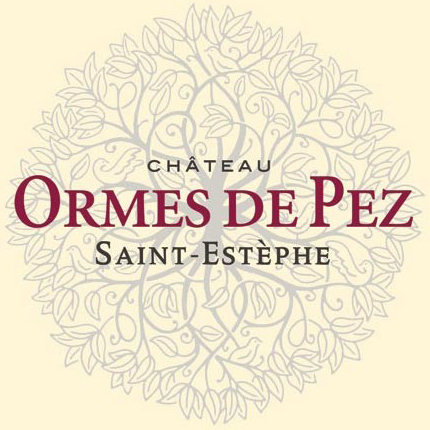
The Estate
Although Lynch-Bages is without a doubt the flagship of the Domaines Jean-Michel Cazes, Ormes de Pez has belonged to the Medoc landscape since the 18th century. At the time of the French Revolution, the current property was called the Domaine de Pez (meaning ”peace” in the local dialect). As for the elms (”ormes”) that have appeared on the bottle labels since 2003, they grew on the grounds of the domaine until this mythical variety of tree ceased to grow in Europe in the 1950’s. From the 19th century onwards, the château had numerous owners (Southard and Pieck, Berthé, Carrère, Alibert, Meiners and Allemand, Eschenauer, Johnson, Miaihle), before becoming a part of the Cazes family. In around 1880, Marie Cazes married Jean Guillou, the Ormes de Pez Cellar Master. He was sadly killed at the very beginning of the Great War and so Marie, a woman of great character, subsequently took over the business. Her brother Jean-Charles Cazes purchased Ormes de Pez in 1940. Jean-Michel Cazes later redeveloped and modernized the traditional XVIII century buildings in the early 80’s.

Château Ormes de Pez Saint-Estèphe
Viticulture: The wines from Ormes de Pez are made with the same care and attention as those from Château Lynch-Bages (Grand Cru classé de Pauillac). The technical teams, overseen by Tonio Sanfins, prioritize integrated methods of agriculture which include the use of neutral products for the environment, optimized plant-health control and fallow periods for soil rest. The technicians are constantly developing innovative methods that allow the vineyards to be handled in the most precise and efficient way. Satellite photography has been used since 2010 in order to identify homogenous intra-parcel areas. The technicians are also actively involved in the development of new tractors and are working in close collaboration with the manufacturer. Lastly, the ‘massal selection’ program allows them to preserve the vineyard’s genetic heritage and formulate vine schemes based on historical plantings at Ormes de Pez.
Harvest: Manual
Vinification: Takes place at the domaine under the management of Daniel Llose and Nicolas Labenne. Grapes are divided into temperature-controlled stainless-steel vats. Alcoholic fermentation and maceration last for around 20 days during which progressive cycles of ‘rack and return’ and pumping over are carried out. This traditional winemaking method prioritizes a gentle extraction of colors and tannins.
Aging: 15 months in French oak barrels, 45% new oak.
Tasting Notes: The wines from Ormes de Pez are powerful yet characterized by their harmonious structure. They are indulgent, pleasurable and combine a smooth, fleshy texture with the distinctive elegance of a Saint-Estèphe. Made using the traditional grape varieties, these wines are rich, full-bodied and generous. They are made of predominantly Cabernet Sauvignon and complemented by a significant amount of Merlot for a combination of longevity and smoothness. The resulting wines are rich and fruity with a rather imposing tannic backbone. They are seductive in their youth and develop their finesse after a few years of bottle age.
2016 Reviews: “The 2016 Ormes de Pez is deep garnet-purple in color with red and black currants, earth, sage and chargrill on the nose. The palate is medium-bodied, refreshing and chewy with an herbal lift.” – 91pts, Wine Advocate
Château Palene
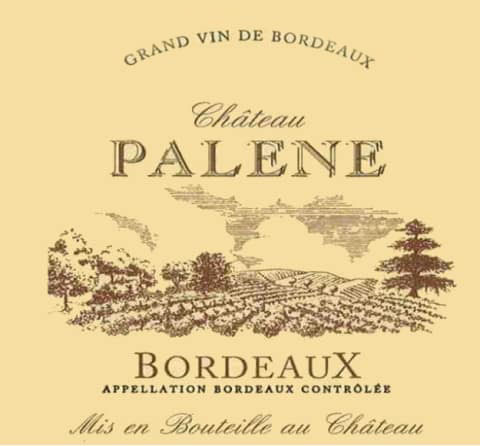
Château Palene is located within the small village of Ladaux, situated in the heart of the Entre-Deux-Mers appellation of Bordeaux. Entre-Deux-Mers is the largest sub-region of Bordeaux with 1,500 hectares of vineyards, and is translated as “Between two seas.” Château Palene is indeed located between two bodies of water-the Garonne and the Dordogne-an area that has been cultivated by the Maubrac Guerin family for many years. The estate covers an area of over 50 hectares of vines which they have had possession of for more than a century. Today, it is one of the oldest Bordeaux estates in the region, and is managed by the family’s 4th generation of winemakers.The Estate

Chateau Palene Rouge
Grape Varietals: The vineyard is planted with both red and white grape varietals, 40 hectares of which are dedicated to Merlot, Cabernet Sauvignon and Cabernet Franc, with the remaining 15 hectares reserved for white varietals such as Semillon (50%), Sauvignon Blanc (30%), and Muscadelle (20%).
The Terroir: The landscape is lush, green, and fertile, with gentle slopes that rise anywhere between 33 and 330 ft (10–100m) above sea level. The vineyard is planted with good exposure to the east and west on sand, limestone, and clay soils at a density of 3,000 to 4,000 rootstocks per hectare. The average age of the vines is about 20 years old. The average yield is 65 hl/ha, and the annual production is about 600 hl for the white wines and 2,400 hl for the reds.
Varietal Blend: 50% Merlot, 40% Cabernet Sauvignon, 10% Cabernet Franc
Vinification: Skin maceration during the alcoholic fermentation. Temperature control.
Tasting Notes: Deep red color with purple highlights. Chateau Palene is a mix of black fruit aromas and exotic woodsy notes. The palate is round with polished tannins and a pleasant fruity finish.
Château Palmer
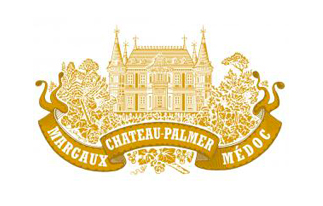 Overview
Overview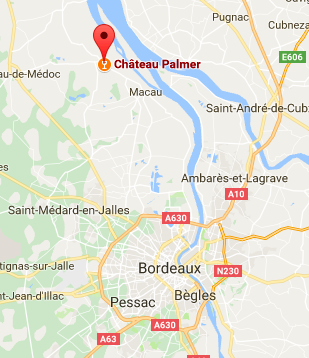
Château Palmer is a winery in the Margaux AOC of the Bordeaux region of France. The wine produced here, was classified as one of fourteen Troisièmes Crus (Third Growths) in the historic Bordeaux Wine Official Classification of 1855. The property is situated in the communes Margaux and Cantenac, and its wine is considered to be one of the two most popular Third Growths.
Since 1998, the Château has been producing also a second label, not a second wine, Alter Ego de Palmer, selected from the same quality terroirs, but employing different wine-making techniques and different proportions of grapes. In order to produce an earlier-drinking wine. Some 40% of the estate’s production, is now sold as Alter Ego de Palmer. The result has been a significant reduction in the quantity of wine sold as Château Palmer (from nearly 20,000 cases before the introduction of Alter Ego de Palmer to 11,000-12,000 cases currently). The previous second wine, La Réserve de Général, is not a component of Alter Ego de Palmer, but is now sold off in bulk.
History
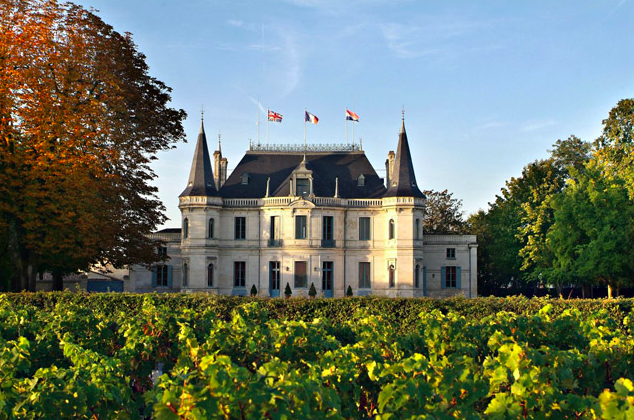 Once a part of the ancient estate, Château d’Issan, divided by the heirs of the Foix-Candale family in 1748, 50 hectares of vineyards came to the Gascq family. Though without association to any noble château, the wine produced became Château de Gascq, quickly established in the market and served at the court of Versailles under Louis XV.
Once a part of the ancient estate, Château d’Issan, divided by the heirs of the Foix-Candale family in 1748, 50 hectares of vineyards came to the Gascq family. Though without association to any noble château, the wine produced became Château de Gascq, quickly established in the market and served at the court of Versailles under Louis XV.
By 1814, the widow of the final Gascq heir, Madame Marie Bumet de Ferrière, sold the property for fr 100,000 to an Englishman, Major General Charles Palmer. Having retired from military life, Palmer invested in the property over the following years, acquiring additional land and facilities. By 1831, the domain extended 163 hectares with 82 hectares under vine, buildings in Issan, Cantenac and Margaux, and had a reputation on a par with Château Margaux and Château Beychevelle. In the early 1840s, Palmer had economic difficulties which would later affect the estate’s position in the 1855 Classification, and was forced to sell the property to madame Françoise-Marie Bergerac in 1843 for fr 410,000, at a substantial loss.
Before World War II, Château Palmer’s owners bought Château Desmirail, another Third Classified Growth, and uniquely in 1963 Palmer wines were sold under the Desmirail name.
Since 2004, Palmer has been managed by Thomas Duroux, formerly a winemaker of Tenuta Dell’Ornellaia.
The Terroir
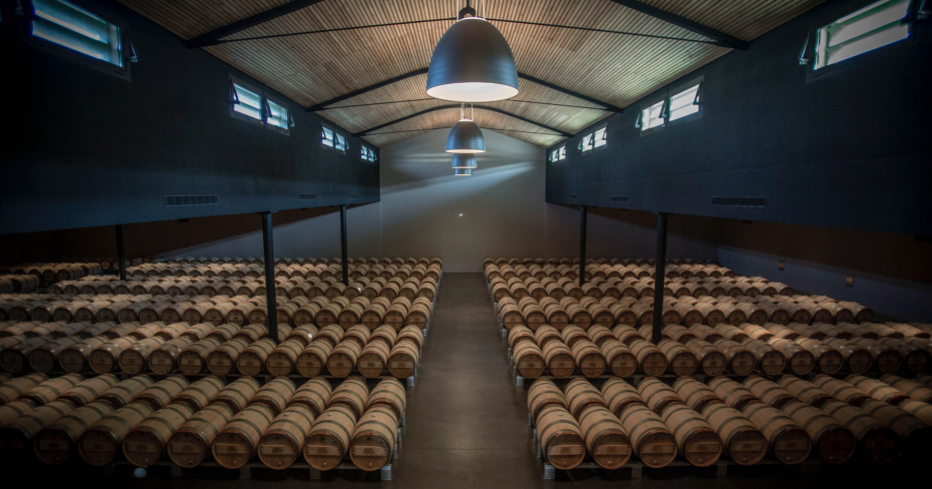 Location: Château Palmer’s has a natural logic: a long strip of land set between the Atlantic Ocean and the Gironde estuary. Behind the alluvial land of the palus sits the Brauzes plateau, the first gravelly terrace. This is well-drained land, rich with the deposits of the Garonne and Dordogne rivers, but washed clean of organic matter. Difficult soil for agriculture, but exceptional for grape growing.
Location: Château Palmer’s has a natural logic: a long strip of land set between the Atlantic Ocean and the Gironde estuary. Behind the alluvial land of the palus sits the Brauzes plateau, the first gravelly terrace. This is well-drained land, rich with the deposits of the Garonne and Dordogne rivers, but washed clean of organic matter. Difficult soil for agriculture, but exceptional for grape growing.
Acreage: 55 Ha
Grape Varietals: A grammar composed of equal parts Cabernet Sauvignon and Merlot, topped off with a touch of Petit Verdot. The last is often an exception in the Médoc, but at Château Palmer a rule. Because it is not the variety that determines the quality of the wine, but rather how each variety’s essential characteristics asserts its influence.
47% Cabernet Sauvignon, 47% Merlot, 6% Petit Verdot
Density of the vines: 10.000/Ha
Average age of the vines: The vines have an average age of 38 years and about 1 hectare of land is cleared and replanted each year.
Aging: 18 to 21 months less half of them in new wood.
Biodynamics: Neither a preconceived idea, nor a posture. At first, biodynamics was simply an experiment, sparked by curiosity. The first trials in 2008 proved inconclusive, so meetings were organized with adherents of the method. Slowly, it became evident what truly lies at the heart of biodynamics: a return to the essence of farming. And thus an idea became a conviction – to turn the page on a monoculture, and to recreate a living agricultural organism, in all its diversity. Now, sheep graze, grass grows, flowers and plants with healing properties bloom, and agrochemicals have disappeared. With biodynamics, complexity becomes a source of shared enrichment, where the fruits of human labour benefit people, plants, and all that surrounds. An exquisite equilibrium.

Château Palmer Margaux
Overview: Troisieme Grand Cru Classe in 1855. This is the second most highly rated Margaux wine (based on critic scores): the 2015 vintage was given a score of 96 by The Wine Advocate and the 2015 vintage was given a score of 18/20 by Jancis Robinson. This wine has received more awards than any other wine from the region: the 2011 vintage was awarded Blue-Gold from the Sydney International Wine Competition, and the 2010 vintage was awarded 3 Stars Coup De Coeur from the Guide Hachette des Vins. Among the highest-priced wines from Margaux.
Grape Varieties: Merlot accounts for over 40% of the blend, and as much as 60% in some older vintages, and Petit Verdot is also a relatively significant component, always restricted to 35 hl/ha in order to maximize ripening, and it may account for up to 8% in some recent vintages. The vines have an average age of 38 years and about 1 hectare of land is cleared and replanted each year.
Soil: These stones vary in type, including quartz and quartzite, chalcedony and lyddite, originating from the Quaternary era, much of it arriving in Bordeaux having been swept down from the Pyrenees by the Garonne. They form a fairly deep surface layer, up to four metres deep in places, over a hard bedrock.
Aging: 21 months in oak of which 45% is new

Alter Ego de Palmer
Overview: The Second Wine of Chateau Palmer, Alter Ego was born with the 1998 vintage. It resulted from a new approach to selecting and blending devised to interpret the Château Palmer terroir differently without departing from the values that make the reputation of our wines – namely, finesse and elegance, aromatic richness, harmony and length.
Grape Varieties: Merlot, Cabernet Sauvignon (percentages vary depending on the vintage)
Vinification: At the end of the summer, the slowly maturing berries are regularly tasted to evaluate their potential. The wine makers pay attention to the taste of the grape, the thickness of the skin, and the resistance of the seed. By this time, they already have a sense of what the wines will be like. They are looking for lush grapes for Alter Ego that will release the aromas of fresh fruit. Harvesting and vinification decisions are made based on the idea that they have of the Château Palmer and Alter Ego style. Final blend tastings usually come to confirm their intuitions.
Aging: The batches chosen for Alter Ego are then blended and put into barrels to age for 18 months. The fruitiness and aromatic intensity are preserved by the use of a moderate percentage of new oak barrels (25 to 40%).
Tasting Notes: Offering intense, crispy and juicy fruits, Alter Ego is a spontaneous uninhibited wine, soft and round as soon as it has finished barrel ageing. Its lush aromas and supple tannins make it a wine that can be appreciated in the first years after bottling.
Château Pape Clément
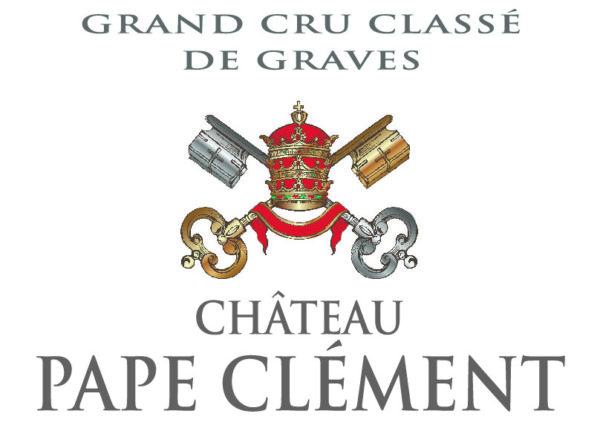
The History
For more than 750 years, Château Pape Clément has been producing fine wines on the same terroir, with the first harvest recorded as taking place in 1252. At this time, it was called Domaine de la Mothe. The estate was purchased at the end of December 1299 by Gaillard de Goth, son of a famous family from the south of Bordeaux. This purchase was made at the request of Bertrand de Goth, who had just been appointed Archbishop of Bordeaux, and for this reason could not accede to the property. On being named Pope in 1305 (with the support of Philip IV, King of France), Bertrand De Goth took the name Pope Clement V, and in 1306, a few days before the death of Gaillard de Goth, Clement V was given the Pessac estate by his dying brother, thus giving his name to the Château.
Bertrand de Goth liked vine-growing and greatly concerned himself with the vineyard of la Mothe. When he became Pope, he considerably contributed to the development of viticulture, particularly in the Rhône Valley and all around Avignon. It is partly thanks to him that certain growths in Châteauneuf-du-Pape, Gigondas, and Beaumes-de-Venise could and still can rival the best wines of Bordeaux.
Many centuries later at the turn of the 1980s, Bernard Magrez, a passionate wine entrepreneur, took the reins at the Château and was to give this grand cru classé an unprecedented international aura. In 1985, he marked the definitive return to high-level production, by now further enhanced by the talents of the famous consulting oenologist, Michel Rolland. Bernard Magrez put in place vinification by plot, a guarantee of complexity and refinement in the wine: the grapes from different plots are vinified in separate tanks, to allow them to fully express their specific characteristics before blending.
Bernard Magrez made every effort to allow the exceptional terroir of Château Pape Clément to stand the test of time and express the finesse that had made the reputation of its wines. It was in 2009 that these efforts were rewarded with the mythical score of 100 from the critic Robert Parker for Château Pape Clément white, and then the same score for Château Pape Clément red the following year.
Thanks to hard work, constant questioning, the alliance of tradition and innovation and a remarkable terroir, Château Pape Clément, Grand Cru Classé de Graves, continues each year to amaze wine lovers with its exceptional quality.
The Terroir
The estate of Château Pape Clément is part of the Pessac-Léognan appellation situated in the Graves viticultural area. Based on a soil with exceptional components, the 60 hectares of this vineyard are devoted to the meeting of passion and work.
The Château terroir is situated on the oldest of the alluvial terraces, called the “Pyrenean gravel layer”. The originality of the Pape Clément site lies in the presence of a thin film of more recent Garonne gravel, deposited a million and a half years ago.
The diversity of the terroir of Pape Clément allows for the ripening of Cabernet Sauvignon, Merlot, Cabernet Franc, and Petit Verdot for the production of the red wine and Sauvignon Blanc, Sauvignon Gris, Sémillon, and Muscadelle for the production of the white wine.

Château Pape Clément Pessac-Léognan Grand Cru Classé de Graves
Grape Varieties: 56% Cabernet Sauvignon, 40% Merlot, 4% Cabernet Franc.
Viticulture: Parcel based management. Grass grown between the grass, ploughing between vine rows. Integrated pest management, vigor control. Debudding, removal of side shoots, green harvesting. Tillage with animal traction. Terra Vitis Label and HVE3 Label (high environmental value 3th level ).
Harvest: Manual harvest in small crates
Vinification: First sorting in the vineyard, manual harvest in crates. Manual destemming berry by berry and use of a sorting table. Transfer into 30-70 hl wooden vats by gravity flow. Low temperature pre-fermentation maceration. Manual punching down. 30-40 day maceration. The wine is run off into French oak barrels by gravity flow. Malolactic fermentation in oak barrels.
Aging: 18 months in oak barrels

Le Prélat De Pape Clément Rouge
Appellation: AOC Graves
Terroir: The Prélat De Pape Clément’s vineyard is nestled in the heart of the Graves region, on the left bank of the Garonne River where the soil and the climate are ideal for grapes to ripen and vines to flourish. What’s more, the nearby river and the vineyard’s exposure to the sun help create a microclimate which helps protect and nurture the vines.
Soil: Dig down into the subsoil and you’ll find gravel and a layer of clay and limestone, which absorbs the sun’s heat during the day and releases it at night to produce remarkably full, ripe grapes.
Harvest: Mid-September
Grape Varieties: 77% Merlot, 20% Cabernet Sauvignon, 3% Cabernet Franc
Alcohol Content: 14%
Tasting Notes: Very dark, dense red color. The bouquet is filled with aromas of spices and cocoa. Very expressive on the palate, opening with fruity flavors supported by silky tannins. A captivating finish.

Le Prélat De Pape Clément Blanc
Appellation: AOC Graves
Terroir: The Prélat De Pape Clément’s vineyard is nestled in the heart of the Graves region, on the left bank of the Garonne River where the soil and the climate are ideal for grapes to ripen and vines to flourish. What’s more, the nearby river and the vineyard’s exposure to the sun help create a microclimate which helps protect and nurture the vines.
Soil: Dig down into the subsoil and you’ll find gravel and a layer of clay and limestone, which absorbs the sun’s heat during the day and releases it at night to produce remarkably full, ripe grapes.
Harvest: Mid-September
Grape Varieties: 71% Semillon, 16% Sauvignon Blanc, 12% Sauvignon Gris, 1% Muscadelle
Alcohol Content: 14%
Tasting Notes: Pretty pale gold color with shades of green. Fresh, fruity, balanced, and racy on the nose with a lovely minerality. It reveals notes of fresh apple, lemon, and more slightly ripe lemon, along with a hint of kumquat as well as very discreet hints of orange blossom. The palate is fruity, balanced, medium-bodied, with a mineral structure as well as a certain freshness. This wine expresses notes of fresh ripe lemon, and juicy peach fresh off the vine.




